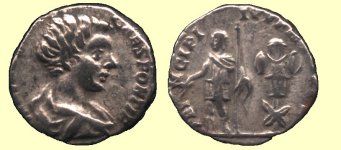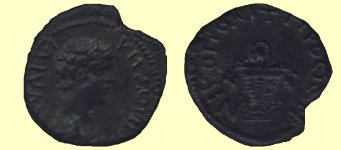
Caracalla 211 - 217 A.D.
By clicking on the pictures you'll be linked to a more complete description of the coin. At the bottom of this page there is a more elaborate biography of the emperor.
 |
Obverse: M AVR ANTON CAES PONTIF |
| Reverse: PRINCIPI IVVENTVTIS | |
|
Fieldmarks: -
|
|
| Exergue: - |
 |
Obverse: M AV KAI ANTΩNINOC |
| Reverse: NIKOπOΛIT πPOC ICTP | |
|
Fieldmarks: -
|
|
| Exergue: - |
Caracalla 211 - 217 A.D.
Lucius Septimius Bassianus better known by his nickname Caracalla was born on the 4th of April 188 in Lugdunum. His last name was given him in honor of his grandfather, Julius Bassianus, high priest of the sun god El-Gabal at Emesa. The nickname Caracalla was given to him as he tended to wear a long Germanic cloak of that name, this nickname however was never used officially. Caracalla was the eldest of the two sons of Septimius Severus his brother was named Geta. In 193 his father was declared emperor by his troops at Carnuntum. In 195 when he was seven years old Caracalla was promoted to Caesar with the full intention to be the heir to his fathers throne. His name was changed to Marcus Aurelius Antoninus as a way of connecting the family of Severus to that of the Antonines. In February of 197, Caracalla was made co-Augustus joining his father as ruler of the empire. At the age of 14 he got married but he hated his wife and the marriage ended in less than three years with no children. In 205 Caracalla was made consul alongside his 11 month younger brother Geta, with whom he lived in bitter rivalry. This reckless sibling rivalry that sometimes resulted in physical injury was of great concern to their father. From 205 to 207 Severus had them live together in Campania, in his own presence, in order to try and heal the rift between them, this setup however failed. The emperor believed the lack of responsibilities and lazy life in Rome contributed to the ill-will between his sons and decided that the family would travel to Britain to oversee military operations against the wild and unruly Scots. Caracalla was involved in directing the army's campaigns, while Geta was given civilian authority. Then in 209 came a severe setback to Caracalla's aspirations when Severus also raised Geta to the rank of Augustus with the intention of the two brothers ruling the empire together. Septimius Severus died in February of 211 at Eboracum. On his deathbed he advised his two sons to: "Agree with each other, give money to the soldiers and scorn all other men." Septimus Severus' last words unfortunately where to no avail, the rivalry between Caracalla and Geta became public. The two emperors lived in separate palaces and each had their own guard. To solve their differences they came up with the idea of dividing the empire, this however was strongly opposed by their mother Julia Domna who feared a civil war and the idea was swept under the table. Somewhere during December of 211 AD, Caracalla convinced his mother to call Geta for a reconciliation meeting in her residence. It was a trick, in his mother's house Caracalla's soldiers attacked Geta and he died in his mother's arms. She was not allowed to mourn for her killed son. A massacre of Geta's supporters followed, and Cassius Dio (a contemporary historian) tells us that some 20,000 people were killed. Also portraits and statues of Geta where destroyed and his coins where molten down in order to erase him from public memory.
Soon after Caracalla became
emperor he implemented several administrative reforms. One of the first things
he did was to increase the pay and legal rights of the praetorian
guard and the soldiers to assure their loyalty. He also redistributed the
legions to a maximum of two per province to lessen the chance of a rebellion
in the provinces. In 212 Caracalla issued his most famous law, the so called
Constitutio Antoniniana. By this law everyone in the empire, with the exception
of slaves, was granted Roman citizenship. This allowed for greater standardization
in the increasingly bureaucratic Roman state and a larger income from taxes.
Furthermore he reformed the monetary system and was apparently an able judge
when hearing court cases. Caracalla also started construction on the baths in
Rome that would bear his name. This was a huge project, the entire complex could
hold 1600 bathers and the main bath measured 56 by 24 meters.
In 213 he began a military campaign against
the Alemanni
along the borders of Upper Germany and Raetia,
Caracalla defeated them in battle near the river Rhine,
but failed to win a decisive victory. He then changed his tactics and instead
sued for peace, promising to pay the barbarians an annual subsidy. This settlement
was seen as a huge failure and humiliation for the troops and to the emperor
himself (Later emperor Severus Alexander
was killed by his soldiers for exactly such a treaty) but Caracalla's tremendous
popularity with the troops allowed him to get away with it. This popularity
was not only caused by the pay rises he had given his soldiers but when with
the troops, he also marched on foot among the ordinary soldiers, ate the same
food and apparently even ground his own flour.
In 214 Caracalla headed east, gathering an army as he passed through the military provinces along the Danube, he reached Asia Minor at the head of a large army. Along the way, Caracalla became increasingly fascinated with Alexander the Great. One part of his newly raised army was a phalanx consisting of 16000 men, in armor of the style of Alexander's Macedonian soldiers. The army was also accompanied by a large contingent of war elephants. He ordered statues of Alexander to be erected and pictures were commissioned, some of them bore a face which was half Caracalla, half Alexander. Because Caracalla believed that Aristotle had had some part in Alexander's death, Aristotelian philosophers were persecuted. In May of 215 AD he reached Antioch in Syria, leaving his great army behind, Caracalla now went on to Alexandria to visit the tomb of Alexander the Great. This illustrious visit was apparently accompanied by riots, and with Caracalla's short temper retribution was swift. The governor of Egypt was executed as were thousands of the city's young men and games and privileges were revoked. After this massacre Caracalla headed back to Antioch, where in 216 AD no fewer than eight legions were waiting for him. With this great force Caracalla attacked Parthia, which was preoccupied with a bloody civil war. The frontiers of the province of Mesopotamia were pushed further east but attempts to overrun Armenia failed. Instead Roman troops moved unopposed across the Tigris into Media and finally withdrew to Edessa to spend the winter there. Parthia severely weakened by their civil war could muster almost no response to these attacks. Caracalla sensed his chance and planned further expeditions for the next year, most likely hoping to make some permanent acquisitions to the empire.
Caracalla had several illnesses for which he sought relieve in several temples and shrines during his career and one of those trips would lead to his murder in 217 AD. Caracalla allowed himself to be accompanied by only a small, select corps of bodyguards on an early spring trip from the camp at Edessa to the temple of the moon-god at Carrhae, about 25 miles away. During the journey back on the 8th of April 217, Caracalla was killed. The returning guards claimed the emperor was ambushed by Julius Martialis, an officer in the imperial bodyguard when he relieved himself out of sight from the other guards. Martialis was himself killed by the avenging guards, or so the story went. But there were strong suspicions that the mastermind behind the murder was the commander of the praetorian guard, Marcus Opelius Macrinus.
Caracalla's ashes were sent
back to Rome where they were laid to rest in the Mausoleum of Hadrian. He was
deified in 218 AD. Although his reign was short and bloody his reforms had great
implications for the future of the empire, especially the pay raise for soldiers
would prove a huge burden for future emperors as soldiers began to expect them
when a new Augustus rose to power.
For this biography I've used the texts from the following websites:
http://www.imperiumromanum.com/
http://www.roman-emperors.org/
http://www.roman-empire.net/
And from: Gibbon's Decline and fall of the Roman empire.